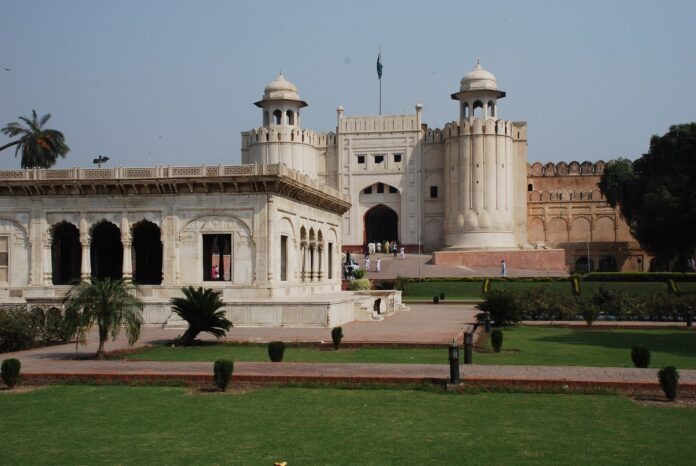Discovering the Majestic Heritage of Pakistan
Introduction
Lahore Fort is one of the most well-known historical landmarks in Pakistan. This magnificent structure is a testament to the grandeur of the Mughal Empire, and it holds great importance to the country’s rich culture and heritage. The fort is located in the heart of Lahore, the capital city of Punjab province.
Lahore Fort is also known as Shahi Qila, which means “Royal Fort” in Urdu. It was constructed during the 16th century by Emperor Akbar, who was one of the greatest rulers in Mughal history.
The fort has since been expanded and renovated by various rulers over time. The significance of Lahore Fort extends beyond just its historical value.
It’s a symbol of national pride and identity for Pakistanis. The site serves as a physical reminder of their past struggles against foreign invaders who sought to dominate them, and it represents their cultural resilience to preserve their unique heritage.
One can find many structures within Lahore Fort that highlight this history, including palaces, mosques, gardens, halls, and gateways. These buildings are not only architecturally impressive but also provide important insight into life during different periods.
Visiting Lahore Fort today offers an immersive experience that educates visitors about Pakistan’s past while providing stunning views that showcase its beauty as well. In this article, we will explore more about this remarkable landmark – from its history to must-see attractions for tourists – so you can get a better understanding of why Lahore Fort is so vital to Pakistani culture and heritage.
History of Lahore Fort
Origins of the Fort Dating Back to the Mughal Empire
Lahore Fort, also known as Shahi Qila, is a historical landmark located in the heart of Lahore, Pakistan. This magnificent structure dates back over 400 years to the Mughal Empire, which ruled over a large part of South Asia from the early 16th century until the mid-19th century. The fort was built during the reign of Akbar the Great, who was one of India’s most powerful and influential emperors.
The construction of Lahore Fort began in 1566 and continued for many years afterward under various rulers. The fort was expanded and fortified by Akbar’s son Jahangir, who added several new buildings and structures to it.
Later on, Shah Jahan also made his contributions to Lahore Fort by building some important buildings such as Diwan-e-Aam (Hall of Public Audience) and Moti Masjid (Pearl Mosque). These contributions gave further grandeur to an already magnificent fortress.
Construction and Expansion by Various Rulers Throughout History
Over time, different rulers contributed to fort’s construction and expansion. Along with Jahangir and Shah Jahan’s efforts which are visible inside Lahore Fort even today, other rulers including Maharaja Ranjit Singh also contributed significantly towards its growth during their respective reigns over Punjab region.
In addition to these various additions over centuries,the fort saw considerable reformation during British rule in India as well. They used it for military purposes like barracks for soldiers but carried out renovations while trying to maintain its original architecture.
Role of the Fort in Battles and Political Events
Throughout history,Lahore Fort played an important role in battles fought between kingdoms that ruled over Pakistan region.The fort was pivotal during different wars.The most notable event was the Battle of Lahore in 1758, which was fought between the Durrani Empire and the Marathas. This battle was significant because it led to Ahmad Shah Durrani becoming the ruler of Punjab, and it also marked the end of the Maratha expansion into South Asia. Lahore Fort also played a key role in various political events that took place in Pakistan after independence from British rule.
It was used as a prison by both British and Pakistani governments at different times, and some notable political leaders were held captive inside its walls during this period. Overall,Lahore Fort has been an important witness to numerous historic events and remains one of Pakistan’s most iconic landmarks today.
The Architecture and Design of Lahore Fort
The Lahore Fort is a masterpiece of Mughal architecture, with a blend of Persian, Hindu, and Islamic styles. It boasts several palaces, mosques, and gardens within its walls.
The Palaces
One of the most popular attractions within the fort is Sheesh Mahal or Palace of Mirrors. It was built by Emperor Shah Jahan in the 17th century for his wife Mumtaz Mahal. The palace is adorned with intricate mirror work that reflects light in a thousand different directions creating an awe-inspiring sight.
Another palace worth mentioning is the white marble Naulakha Pavilion that stands near the entrance to the fort. It was built by Emperor Aurangzeb and features beautiful carvings on its exterior as well as on its interior.
The Mosques
The Badshahi Mosque is located just outside the walls of Lahore Fort and has been a significant landmark for centuries. Built by Emperor Aurangzeb in 1673 AD, it’s one of the largest mosques in Pakistan and can accommodate up to 100,000 worshippers at once. The mosque has four minarets that stand tall at 176 feet high making it visible from afar.
The Gardens
Shahi Baradari (royal pavilion) is among the most picturesque spots in Lahore Fort because of its stunning garden design . It contains two levels with arched openings providing ventilation. The lower level has fountains while flowers adorn both levels adding to their beauty .
Another famous garden located within Lahore Fort’s boundaries is Hazoori Bagh Garden which was commissioned by Maharaja Ranjit Singh who ruled Punjab from 1801–1839 AD . He also ordered to build a rampart wall around it to separate the garden from the fort’s civilian population.
The Unique Features
The intricate tile work and carvings that can be found throughout Lahore Fort are some of the most impressive examples of Mughal artistry. The tile work includes a variety of colors, patterns, and images that depict animals, flowers, and people in various scenes.
These tiles were imported from Iran and Central Asia to decorate the walls of royal palaces such as Sheesh Mahal. Moreover, many fort buildings have beautiful carved marble or sandstone panels that depict fine detail such as scenes from life in India or battles fought by Mughal emperors.
The Influence of Different Cultures
The Mughals were known for blending Persian, Hindu, and Islamic styles in their architecture. This fusion of different cultures is evident throughout Lahore Fort’s design.
For instance, Naulakha Pavilion has Hindu-style carvings while Sheesh Mahal has Persian-style mirror work. The gardens also reflect a mix of cultures with their use of plant species from Persia and India.
Lahore Fort is an architectural marvel that represents centuries-old heritage in Pakistan. Its blend of different styles reflects the cultural diversity present in Pakistan today.
Must-See Attractions for Tourists
Lahore Fort, also known as Shahi Qila, is home to some of the most beautiful and historically significant attractions in Pakistan. The fort is a must-visit destination for tourists who are interested in learning more about the country’s rich history and culture.
Sheesh Mahal (Palace of Mirrors)
One of the most popular attractions within Lahore Fort is Sheesh Mahal, also known as Palace of Mirrors. This stunning palace was constructed during the reign of Emperor Shah Jahan and features intricate mirror work on its walls and ceilings.
The palace was used as a private residence by the emperor and his family members. Visitors to Sheesh Mahal will be amazed by the shimmering beauty of its interior.
Every inch of the palace is covered in tiny mirrors that reflect light in all directions, creating a dazzling visual effect. The palace’s intricate floral patterns add a touch of elegance to its design.
Naulakha Pavilion
Another must-see attraction within Lahore Fort is Naulakha Pavilion, which was built during Emperor Aurangzeb’s reign. This pavilion was used as a summer retreat by Mughal rulers and features stunning views of Lahore city.
Naulakha Pavilion is made entirely out of marble, giving it an ethereal beauty that captivates visitors’ attention. Its intricate carvings depict stories from Mughal history and offer a glimpse into life at court during this era.
Diwan-e-Khas (Hall of Private Audience)
Diwan-e-Khas, or Hall of Private Audience, is another popular attraction within Lahore Fort that visitors should not miss out on. This hall was used for private meetings between Mughal emperors and important guests such as nobles or ambassadors.
The hall’s most impressive feature is its throne, which is made entirely out of marble and is adorned with precious gems. Its ceiling features intricate paintings of celestial beings and floral motifs that add to its grandeur.
Why These Attractions Are Significant to Visitors
These attractions within Lahore Fort are not only beautiful but also historically significant. They offer a glimpse into the lives of Mughal rulers and their families, as well as insight into the architecture and design styles prevalent during this era.
Visitors can learn about the different materials used to build these structures, such as marble, sandstone, and brick. They can also appreciate the attention to detail that went into creating these works of art, from the intricate mirror work in Sheesh Mahal to the carvings in Naulakha Pavilion.
In addition to their historical significance, these attractions are a testament to the skill and creativity of Mughal craftsmen who helped build them. Overall, visiting these attractions is an enriching educational experience that helps visitors understand Pakistan’s cultural heritage better.
Lesser-Known Facts About Lahore Fort
The Mysterious Tunnels of Lahore Fort
Lahore Fort is a historical landmark that has been around for centuries, and as such, it holds many secrets and mysteries within its walls. One of the most fascinating aspects of the fort’s history is the network of underground tunnels that run beneath it.
These tunnels were used for a variety of purposes throughout history, including as escape routes during battles and as secret passageways for royalty. One story tells of a tunnel that led from the fort to the nearby Badshahi Mosque.
It was said that this tunnel was used by Mughal Emperor Aurangzeb to travel back and forth between the two sites without being seen by his subjects. Another legend tells of a secret tunnel that connected Lahore Fort to the Shalimar Gardens, which was built by Emperor Shah Jahan.
Despite their intrigue, many of these tunnels are now inaccessible or have been sealed off due to safety concerns or structural damage over time. However, visitors can still catch glimpses of some entrances or openings if they know where to look.
Secret Chambers: Hidden Treasures or Dark Secrets?
The rich history of Lahore Fort also includes stories about hidden chambers or rooms within its walls. While some may contain valuable treasures or artifacts from centuries past, others hold more ominous secrets. One example is the so-called “Khwabgah,” which translates to “dream chamber.” This room was said to have been used by Emperor Jahangir for sleeping and meditation.
However, rumors also suggest that it may have been used for more sinister purposes such as torture or imprisonment. Another hidden chamber within Lahore Fort is known as the “Zebunnisa’s Bath.” This room was named after Princess Zebunnisa Begum, who was imprisoned in this chamber by her own father, Emperor Aurangzeb.
It is said that she was kept here for several years until her eventual release. Despite the dark history behind some of these secret chambers, they remain an intriguing part of Lahore Fort’s past and continue to draw visitors from around the world who are fascinated by their mysterious allure.
Treasure Hunts and Legends
Perhaps one of the most exciting aspects of Lahore Fort’s history is the countless tales of hidden treasures and legends that surround it. These stories have been passed down through generations and continue to capture our imaginations today.
One such legend tells of a hidden treasure that was buried within the walls of Lahore Fort by Emperor Akbar himself. According to this story, Akbar buried a vast fortune within one of the fort’s towers before leaving for his campaign in Afghanistan.
However, despite numerous attempts to find this treasure over the years, it has yet to be discovered. Another interesting legend surrounds a well within Lahore Fort known as “Hathi Paer.” It is said that anyone who can climb down into this well and touch its bottom will be granted three wishes.
While this may seem like nothing more than folklore, many visitors are still drawn to this spot in hopes that there may be some truth behind the legend. There is also a tale about a secret underground chamber located somewhere within Lahore Fort that contains priceless treasures from various emperors throughout history.
This chamber is said to be guarded by supernatural beings who will only reveal its location to someone deemed worthy enough by them. While these stories may seem far-fetched or unlikely, they add an element of mystery and excitement to Lahore Fort’s already fascinating history.
Tips for Visiting Lahore Fort
Hours and Admission Fees
Lahore Fort is open daily from 9 am to 5 pm, but it’s important to note that some of the attractions may close earlier. The admission fee for locals is Rs.20, while foreign tourists will need to pay Rs.500. It’s highly recommended that visitors arrive early in the morning or late in the afternoon to avoid the crowds and heat.
What to Wear
As Lahore Fort is a conservative area, it’s important to dress modestly when visiting. Women should wear clothing that covers their arms and legs, while men should avoid wearing shorts or sleeveless shirts. Additionally, it’s recommended to wear comfortable shoes as there will be a lot of walking involved.
Guided Tours
For first-time visitors or those interested in learning more about the history and architecture of Lahore Fort, guided tours are highly recommended. These tours are led by knowledgeable guides who will take you through all the major attractions while providing historical context and fun stories along the way.
Bring Water and Snacks
As there are limited food options within Lahore Fort itself, it’s best to bring your own water and snacks with you. Also carry a backpack with other essentials such as sunscreen , hat etc.
Cultural Sensitivity
Visitors should be respectful of local customs and traditions when visiting Lahore Fort. This includes not taking photographs of women without permission, not touching artifacts or structures unless allowed by guides or staff members, and refraining from showing public displays of affection.
Conclusion
Visiting Lahore Fort can be an amazing experience for anyone interested in history, architecture or culture . While there are certain things one should keep in mind like dressing conservatively ,bringing your own food and drinks and being culturally sensitive, overall it is an opportunity to learn about the rich history of this region. By following these tips, you can make the most out of your visit to Lahore Fort and leave with a greater appreciation for Pakistan’s cultural heritage.



